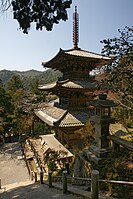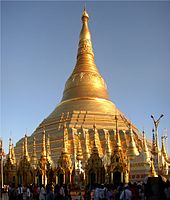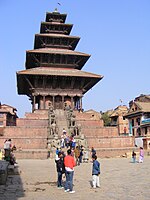Pagoda

Wooden five-story pagoda of Hōryū-ji in Japan, built in the 7th century, one of the oldest wooden buildings in the world.

Bird's eye view of the Patan Durbar Square's pagoda temple of Nepal. It has been listed by UNESCO as a World Heritage Site.

Great Wild Goose Pagoda of Xi'an in China, built in the 7th century, made of brick.

Seokgatap of Bulguksa in South Korea, built in the 8th century, made of granite. In 1966, the Mugujeonggwang Great Dharani Sutra, the oldest extant woodblock print and several other treasures were found in the second story of this pagoda.
A pagoda is a tiered tower with multiple eaves, built in traditions originating as stupa in historic South Asia[1][2] and further developed in East Asia or with respect to those traditions, common to Nepal, China, Japan, Korea, Vietnam, Myanmar, India, Sri Lanka and other parts of Asia. Some pagodas are used as Taoist houses of worship. Most pagodas were built to have a religious function, most commonly Buddhist, and were often located in or near viharas. In some countries, the term may refer to other religious structures. In Vietnam and Cambodia, due to French translation, the English term pagoda is a more generic term referring to a place of worship, although pagoda is not an accurate word to describe a Buddhist vihara. The modern pagoda is an evolution of the stupa which originated in ancient India.[3][4][1] Stupas are a tomb-like structure where sacred relics could be kept safe and venerated.[5] The architectural structure of the stupa has spread across Asia, taking on many diverse forms as details specific to different regions are incorporated into the overall design.
Contents
1 Etymology
2 History
2.1 Symbolism
2.2 Architecture
3 Some notable pagodas
4 See also
5 Notes
6 References
7 External links
Etymology
One proposed etymology is from a South Chinese pronunciation of the term for an eight-cornered tower, Chinese: 八角塔, and reinforced by the name of a famous pagoda encountered by many early European visitors to China, the "Pázhōu tǎ" (Chinese: 琶洲塔), standing just south of Guangzhou at Whampoa Anchorage.[6] Another proposed etymology is Persian butkada, from but, "idol" and kada, "temple, dwelling."[7]
Another etymology, found in many English language dictionaries, is modern English pagoda from Portuguese (via Dravidian), from Sanskrit bhagavati, feminine of bhagavat, "blessed", from bhag, "good fortune".
Yet another etymology of pagoda is from the Sinhala word dāgaba which is derived from Sanskrit dhātugarbha or Pali dhātugabbha: "relic womb/chamber" or "reliquary shrine", i.e. a stupa, by way of Portuguese.[8]
History

Kek Lok Si pagoda tiers labelled with their architectural styles
The origin of the pagoda can be traced to the stupa (3rd century BCE).[9] The stupa, a dome shaped monument, was used as a commemorative monument associated with storing sacred relics.[9] In East Asia, the architecture of Chinese towers and Chinese pavilions blended into pagoda architecture, eventually also spreading to Southeast Asia. The pagoda's original purpose was to house relics and sacred writings.[10] This purpose was popularized due to the efforts of Buddhist missionaries, pilgrims, rulers, and ordinary devotees to seek out, distribute, and extol Buddhist relics.[11]
On the other side, the stupa emerged as a distinctive style of Newa architecture of Nepal and was adopted in Southeast and East Asia. Nepali architect Araniko visited China and shared his skills to build stupa buildings in China.[12][13]
These buildings (pagoda, stupa) became prominent as Buddhist monuments used for enshrining sacred relics.[9]
Symbolism
Chinese iconography is noticeable in Chinese pagoda as well as other East Asian pagoda architectures. The image of Gautama Buddha in the abhaya mudrā is also noticeable in some Pagodas. Buddhist iconography can be observed throughout the pagoda symbolism.[14]
In an article on Buddhist elements in Han dynasty art, Wu Hung suggests that in these tombs, Buddhist symbolism was so well-incorporated into native Chinese traditions that a unique system of symbolism had been developed.[15]
Architecture
Pagodas attract lightning strikes because of their height. Many pagodas have a decorated finial at the top of the structure, and when made of metal, this finial, sometimes referred to as a "demon-arrester", can function as a lightning rod.[dubious ] Also Pagodas come in many different sizes, as some may be small and others may be large.[16]
Pagodas traditionally have an odd number of levels, a notable exception being the eighteenth century pagoda designed by Sir William Chambers at the Royal Botanic Gardens, Kew, London.
The pagodas in Myanmar, Thailand, Laos and Cambodia are very different from Chinese and Japanese pagodas. Pagodas in those countries are derived from Dravidian architecture.[17]
Some notable pagodas
Tiered towers with multiple eaves:
Songyue Pagoda on Mount Song, Henan, China, built in 523.
Mireuksa at Iksan, Korea, built in the early 7th century.
Bunhwangsa at Gyeongju, Korea, built in 634.
Xumi Pagoda at Zhengding, Hebei, China, built in 636.
Daqin Pagoda in China, built in 640.
Hwangnyongsa Wooden nine-story pagoda on Hwangnyongsa, Gyeongju, Korea, built in 645.- Pagoda at Hōryū-ji, Ikaruga, Nara, Japan, built in the 7th century.
Giant Wild Goose Pagoda, built in Xi'an, China in 704
Small Wild Goose Pagoda, built in Xi'an, China in 709.
Seokgatap on Bulguksa, Gyeongju, Korea, built in 751.
Dabotap on Bulguksa, Gyeongju, Korea, built in 751.
Tiger Hill Pagoda, built in 961 outside of Suzhou, China
Lingxiao Pagoda at Zhengding, Hebei, China, built in 1045.
Iron Pagoda of Kaifeng, built in 1049, during the Song dynasty.
Liaodi Pagoda of Dingzhou, built in 1055 during the Song dynasty
Pagoda of Fogong Temple, built in 1056 in Ying County, Shanxi, China.
Pizhi Pagoda of Lingyan Temple, Shandong, China, 11th century.
Beisi Pagoda at Suzhou, Jiangsu, China, built in 1162.
Liuhe Pagoda of Hangzhou, built in 1165, during the Song dynasty.
Ichijō-ji, Kasai, Hyōgo, Japan, built in 1171.
The Porcelain Tower of Nanjing, built between 1402 and 1424, a wonder of the medieval world in Nanjing, China.
Tsui Sing Lau Pagoda in Ping Shan, Hong Kong, built in 1486.
Dragon and Tiger Pagodas in Kaohsiung, Taiwan, built in 1976.- Seven-storey Pagoda in Chinese Garden at Jurong East, Singapore, built in 1975.
Pazhou Pagoda on Whampoa (Huangpu) Island, Guangzhou (Canton), China, built in 1600.
Pagoda of the Celestial Lady, in Huế, Vietnam, built in 1601.
Palsangjeon, a five-story pagoda at Beopjusa, Korea built in 1605.
Tō-ji, the tallest wooden structure in Kyoto, Japan, built in 1644.
Nyatapola at Bhaktapur, Kathmandu Valley built during 1701–1702.- The Great Pagoda at Kew Gardens, London, UK, built in 1762.
Trấn Quốc Pagoda, Hanoi, Vietnam, founded in the sixth century.
Reading Pagoda of Reading, Pennsylvania, built in 1908.
Kek Lok Si's main pagoda in Penang, Malaysia, exhibits a combination of Chinese, Burmese and Thai Buddhist architecture, built in 1930.- The pagoda of Japan Pavilion at Epcot, Florida, built in 1982.
- Pagoda of Tianning Temple, the tallest pagoda in the world since its completion in April 2007, stands at 153.7 m in height.
Nepal Peace Pagoda in Brisbane, Australia built for the World Expo '88.
Pagoda Avalokitesvara, Indonesia, tallest pagoda in Indonesia, stands at 45 meters built in 2004.
Stupas called "pagodas":
Global Vipassana Pagoda, the largest unsupported domed stone structure in the world.
Mingun Pahtodawgyi, a monumental uncompleted stupa began by King Bodawpaya in 1790. If completed, it would be the largest in the world at 150 meters.
Pha That Luang, the holiest wat, pagoda, and stupa in Laos, in Vientiane
Phra Pathommachedi the highest pagoda or stupa in the world Nakhon Pathom, Thailand.
Shwedagon Pagoda, a 98-metre (322 ft) gilded pagoda and stupa located in Yangon, Myanmar. It is the most sacred Buddhist pagoda for the Burmese with relics of the past four Buddhas enshrined within.
Shwezigon Pagoda in Nyaung-U, Myanmar. Completed during the reign of King Kyanzittha in 1102, it is a prototype of Burmese stupas.
Uppatasanti Pagoda, a 325-foot tall landmark in Naypyidaw, Myanmar, built from 2006 to 2009, which houses a Buddha tooth relic.
Places called "pagoda" but which are not tiered structures with multiple eaves:
One Pillar Pagoda: Hanoi, Vietnam, is an icon of Vietnamese culture; it was built in 1049, destroyed, and rebuilt in 1954.
Structures that evoke pagoda architecture:
- The Dragon House of Sanssouci Park, which is an eighteenth-century German attempt at imitating Chinese architecture.
- The Panasonic Pagoda, or Pagoda Tower, at the Indianapolis Motor Speedway. This 13-story pagoda, used as the control tower for races such as the Indy 500, has been transformed several times since it was first built in 1913.[18]
Jin Mao Tower in Shanghai, built between 1994 and 1999.
Petronas Towers in Kuala Lumpur, the tallest buildings in the world from 1998 to 2004
Taipei 101 in Taiwan, record setter for height (508m) in 2004 and currently the world's fourth tallest completed building.
Structures not generally thought of as pagodas, but which have some pagoda-like characteristics:
- The Hall of Prayer for Good Harvests at the Temple of Heaven
Wongudan Altar in Korea
The Iron Pagoda of Kaifeng, China, built in 1049

Five-story pagoda of Mount Haguro, Japan

Wooden three-story pagoda of Ichijō-ji in Japan, built in 1171

Yingde pagoda, Qingyuan, Guangdong Province, China, from Johan Nieuhof (1618–1672); Jean-Baptiste Le Carpentier (1606 – c. 1670): L'ambassade de la Compagnie Orientale des Provinces Unies vers l'Empereur de la Chine, 1665

One Pillar Pagoda, Hanoi, Vietnam.

The nine-story Xumi Pagoda, Hebei, China, built in 636
Nyatapola Temple located in Bhaktapur, Nepal, built in 1701–1702

Taipei 101 in Taipei, Taiwan
The Bombardier Pagoda at the Indianapolis Motor Speedway

Shwedagon Pagoda located in Yangon, Myanmar. The whole structure is coated with 60 tons of pure gold
See also
- Architecture of the Song Dynasty
- Cetiya
- Chaitya
- Chinese architecture
- Ta - Chinese pagodas
Gongbei – Chinese Muslim mausoleum with pagoda-style architecture- Stupa
Tō – Japanese pagodas- Vihara
Notes
^ ab "The Origin of Pagodas". China.org.cn. 2002-09-19. Retrieved 2017-01-23..mw-parser-output cite.citation{font-style:inherit}.mw-parser-output q{quotes:"""""""'""'"}.mw-parser-output code.cs1-code{color:inherit;background:inherit;border:inherit;padding:inherit}.mw-parser-output .cs1-lock-free a{background:url("//upload.wikimedia.org/wikipedia/commons/thumb/6/65/Lock-green.svg/9px-Lock-green.svg.png")no-repeat;background-position:right .1em center}.mw-parser-output .cs1-lock-limited a,.mw-parser-output .cs1-lock-registration a{background:url("//upload.wikimedia.org/wikipedia/commons/thumb/d/d6/Lock-gray-alt-2.svg/9px-Lock-gray-alt-2.svg.png")no-repeat;background-position:right .1em center}.mw-parser-output .cs1-lock-subscription a{background:url("//upload.wikimedia.org/wikipedia/commons/thumb/a/aa/Lock-red-alt-2.svg/9px-Lock-red-alt-2.svg.png")no-repeat;background-position:right .1em center}.mw-parser-output .cs1-subscription,.mw-parser-output .cs1-registration{color:#555}.mw-parser-output .cs1-subscription span,.mw-parser-output .cs1-registration span{border-bottom:1px dotted;cursor:help}.mw-parser-output .cs1-hidden-error{display:none;font-size:100%}.mw-parser-output .cs1-visible-error{font-size:100%}.mw-parser-output .cs1-subscription,.mw-parser-output .cs1-registration,.mw-parser-output .cs1-format{font-size:95%}.mw-parser-output .cs1-kern-left,.mw-parser-output .cs1-kern-wl-left{padding-left:0.2em}.mw-parser-output .cs1-kern-right,.mw-parser-output .cs1-kern-wl-right{padding-right:0.2em}
^ "Pagoda". Webpages.uidaho.edu. Retrieved 2017-01-23.
^ "DEVELOPMENT OF STUPA ARCHITECTURE IN INDIA" (PDF). Shodhganga.inflibnet.ac.in. Retrieved 2017-01-23.
^ "The stupa (article)". Khan Academy. Retrieved 2017-01-23.
^ The Columbia Encyclopedia, Sixth Edition. Columbia University Press
^ Chinese Origin of the Term Pagoda: Liang Sicheng's Proposed Etymology
Authors: David Robbins Tien, Gerald Leonard Cohen
Publication: Arts, Languages and Philosophy Faculty Research & Creative Works
DownloadTien, D. R., & Cohen, G. L. (2017) http://scholarsmine.mst.edu/artlan_phil_facwork. David Robbins Tien. Comments on Etymology, October 2014, Vol.44, no. 1, pp. 2–6.
^ Random House Unabridged Dictionary, Second Edition. Random House, New York, 1993.
^ Hobson-Jobson: The Anglo-Indian Dictionary by Henry Yule & Arthur Coke Burnell, first printed 1896, reprinted by Wordsworth Editions, 1996, p. 291. Online Etymology Dictionary by Douglas Harper, s.v. pagoda, at http://www.etymonline.com/ (Accessed 29 April 2016)
^ abc Editors, The (2012-01-26). "pagoda | architecture". Britannica.com. Retrieved 2017-01-23.
^ A World History of Architecture. Michael W. Fazio, Marian Moffett, Lawrence Wodehouse. Published 2003. McGraw-Hill Professional.
ISBN 0-07-141751-6.
^ The Impact of Buddhism on Chinese Material Culture. John Kieschnick. Published 2003. Princeton University Press.
ISBN 0-691-09676-7.
^ "Nepal, China commemorate 57-year-long friendship - China News". SINA English. Retrieved 2017-01-23.
^ The Evolution of Indian Stupa Architecture in East Asia. Eric Stratton. New Delhi, Vedams, 2002, viii,
ISBN 81-7936-006-7
^ The Impact of Buddhism on Chinese Material Culture. John Kieschnick. Published 2003. Princeton University Press.
ISBN 0-691-09676-7. page 83
^ The Impact of Buddhism on Chinese Material Culture. John Kieschnick. Published 2003. Princeton University Press.
ISBN 0-691-09676-7. page 84
^ Terry, T. Philip (1914). Terry's Japanese Empire. Houghton Mifflin. p. 257.
^ Chihara, Daigorō (1996). Hindu-Buddhist Architecture in Southeast Asia. BRILL. p. 28. ISBN 90-04-10512-3.
^ [1]
References
The Impact of Buddhism on Chinese Material Culture. John Kieschnick. Published 2003. Princeton University Press .
ISBN 0-691-09676-7.
A World History of Architecture. Michael W. Fazio, Marian Moffett, Lawrence Wodehouse. Published 2003. McGraw-Hill Professional.
ISBN 0-07-141751-6.
Psycho-cosmic symbolism of the Buddhist stupa. A. B. Govinda. 1976, Emeryville, California. Dharma Publications.
External links
| Wikimedia Commons has media related to Pagodas. |
- Oriental architecture.com
- Culzean Pagoda (Monkey House) - the only stone built pagoda in Britain
"Why so few Japanese pagodas have ever fallen down" (The Economist)









